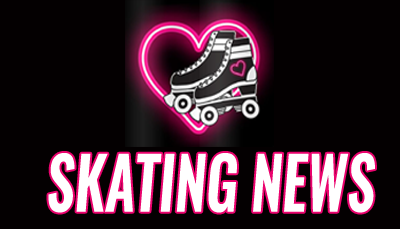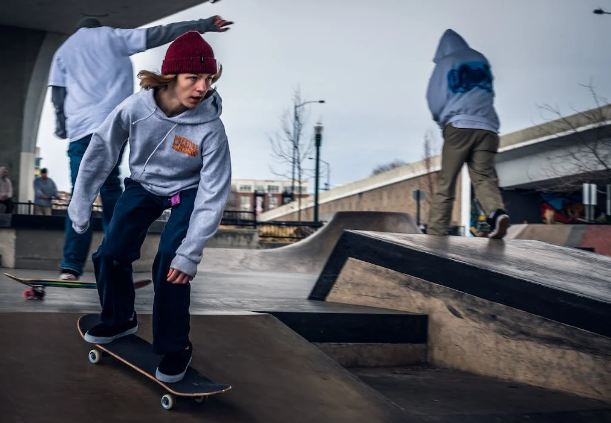Skateboarding has evolved from a niche subculture to a worldwide phenomenon, captivating individuals of all ages with its thrilling mix of athleticism and creativity. However, as exhilarating as skateboarding can be, it’s essential to understand the fundamentals, especially how to stand on a skateboard to ensure a safe and enjoyable experience.
Mastering the basics of skateboard stance lays the foundation for further skill development and allows riders to progress confidently. This blog aims to guide beginners through the process of standing on a skateboard, imparting valuable insights and practical tips to help them find their balance and ride with ease.
The Basic Stances
Skateboarding, like many board sports, relies heavily on finding the right stance for optimal performance. When it comes to stances, there are two main categories: regular stance and goofy stance. In a regular stance, the left foot is placed forward, while the right foot stays at the back of the skateboard. Conversely, in a goofy stance, it’s the right foot that takes the front position, and the left foot is positioned at the back. Determining which stance suits you best is crucial for comfort and balance during rides.
To identify your natural stance, several methods can be employed. One of the most common ways is the “push test.” Imagine yourself walking or running towards an imaginary finish line and being asked to slide on a slippery surface. The foot you instinctively use to push forward is likely your dominant foot, which will be the back foot on the skateboard in a regular stance or the front foot in a goofy stance.
While identifying your stance is important, keep in mind that some skateboarders find it more comfortable to ride in a stance opposite to their dominant foot. This can happen, for example, if a left-handed person prefers a goofy stance because they feel more stable with their right foot forward. Ultimately, the goal is to feel relaxed and balanced on the skateboard, regardless of the stance you choose.
Also, read
Proper Foot Placement
Once you’ve determined your ideal stance, it’s time to focus on proper foot placement. Setting up the skateboard correctly is essential for maintaining balance and control during rides. For a regular stance, place your left foot firmly on the skateboard’s tail while your right foot rests on the front bolts, with the toes angled slightly towards the skateboard’s edge. In a goofy stance, reverse the position, with your right foot on the tail and your left foot angled slightly towards the skateboard’s edge at the front.
While these are the basic foot placements, it’s essential to experiment with different positions to find what works best for you. Some skaters prefer a wider stance for better stability, while others feel more comfortable with their feet closer together. Moreover, the angle of your feet can affect how responsive the skateboard is to your movements.
During the initial stages, it’s normal to feel a bit awkward with foot placement. Practice standing still on the skateboard, adjusting your feet until you find a position that feels secure and balanced. With time and practice, your foot placement will become second nature, enabling you to progress to more advanced maneuvers and tricks with confidence.
Balancing Techniques
Skateboarding requires excellent balance, and learning proper balancing techniques is fundamental to staying on the board without wobbling or falling off. One of the key elements of balance is engaging your core muscles. A strong core not only stabilizes your body but also helps you make subtle adjustments while riding.
When standing on the skateboard, try to distribute your weight evenly across both feet. Avoid putting too much pressure on the toes or heels, as this can throw off your balance and make it difficult to control the board. Instead, maintain a neutral weight distribution to ensure stability.
Finding balance on a moving skateboard can be challenging, especially for beginners. Start by practicing in a stationary position and gradually progress to gentle rolling movements. As you gain confidence, experiment with shifts in weight distribution to get a feel for how it affects the skateboard’s movement.
Remember, balancing on a skateboard is a skill that improves over time with consistent practice. Be patient with yourself, and don’t be discouraged by initial difficulties. With determination and perseverance, you’ll soon find yourself gliding effortlessly on the skateboard, mastering the art of balance and control.
Body Positioning and Posture
Maintaining the correct body positioning and posture is crucial for achieving stability and control while skateboarding. Your body acts as the guiding force behind your skateboard’s movements, so adopting the right posture will greatly impact your overall experience.
Start by keeping your knees slightly bent while riding. This flexed position allows for better shock absorption when encountering cracks, bumps, or uneven surfaces, minimizing the risk of losing balance. Avoid locking your knees as it can make you more susceptible to falling if you hit an obstacle unexpectedly.
Maintaining a relaxed upper body is equally important. Keep your shoulders aligned with your hips and your arms comfortably by your side or slightly outstretched for balance. Refrain from tensing up or hunching over the skateboard, as this can hinder your ability to make fluid movements and limit your control.
Your head plays a significant role in maintaining balance and direction. Keep your gaze fixed forward and focused on the path ahead. Avoid looking down at your feet, as this can disrupt your balance and make it challenging to anticipate obstacles. As you become more proficient, you’ll find that your body intuitively adjusts to maintain equilibrium, and your movements will become more fluid and coordinated.
Initiating Movement
Now that you’ve mastered your stance, foot placement, and balance techniques, it’s time to get moving on the skateboard. Initiating movement on a skateboard primarily involves the push-off technique. To start, place your back foot on the tail (for regular stance) or the front bolts (for goofy stance) and your front foot facing forward.
Begin by pushing off the ground with your back foot, propelling the skateboard forward. As you gain momentum, place your pushing foot back on the skateboard, positioning it in its designated spot. Repeat this process whenever you need to gain speed or maintain motion.
It’s essential to practice controlled pushes to avoid overexertion and maintain your balance. As you progress, you’ll discover that varying the intensity and angle of your pushes can influence your speed and the direction of your skateboard. Moreover, practicing the art of controlled turning will enable you to navigate corners and curves smoothly.
Understanding the Center of Gravity
Understanding the concept of the center of gravity is vital for every skateboarder. The center of gravity refers to the point within your body where the total weight of the body is concentrated. On a skateboard, your center of gravity plays a pivotal role in maintaining stability and executing tricks.
When skateboarding, your center of gravity should be positioned low and in the middle of the skateboard. This low center of gravity enhances your stability and control over the board. Keeping your center of gravity balanced over the skateboard’s width will prevent it from tilting excessively to one side, which could lead to falls.
During tricks and maneuvers, adjusting your center of gravity becomes crucial. For instance, when performing an Ollie, you’ll shift your weight to the back foot before popping the tail, and then quickly shift it forward while leveling the skateboard in the air. Understanding these weight shifts is essential for executing tricks effectively and safely.
As you gain experience, you’ll develop an instinctive understanding of how your body’s positioning affects the skateboard’s behavior. This awareness will be instrumental in pushing the boundaries of your skateboarding skills and exploring more advanced techniques.
How to Balance on a Skateboard
The first step in learning how to balance on a skateboard is finding a comfortable stance. A comfortable stance means that your feet feel stable and secure. You should be able to move your feet from side to side and be able to control your board without feeling like you are going to fall off.
Once you have found a comfortable stance, it is time to focus on your balance. The key to balancing on a skateboard is understanding the weight distribution between your feet and the board. You want to make sure that your feet are evenly distributed on either side of the board and that there is an equal amount of weight on the front and back of the board. This will help you to stay balanced and prevent you from leaning too far to one side or the other.
Once you have found a comfortable stance and have a good understanding of weight distribution, it is time to practice your balance. Start by practicing on a flat surface like the ground or a soft mat. This will help you to feel the board and understand how it reacts to your weight, which will help you when you are riding on an actual skateboard.
Once you have a good understanding of how to balance on a flat surface, try to practice on a skateboard. You can start by rolling slowly and trying to maintain your balance. As you get more comfortable, you can start to try tricks like ollies, kickflips, and grinds.
No matter how comfortable you feel on a skateboard, it is important to wear the right safety gear. Make sure you wear a helmet and pads to protect yourself from falls and other injuries. It is also important to be aware of your surroundings so you don’t get into any unexpected accidents.
Conclusion|How to stand on a skateboard?
learning how to stand on a skateboard is the first step toward a thrilling journey of self-expression, creativity, and personal growth. By understanding skateboard anatomy, adopting proper safety measures, and honing your stance and balance, you lay the groundwork for a fulfilling skateboarding experience.
Overcoming fear, staying persistent, and connecting with the skateboarding community are all vital elements in becoming a confident and skilled skateboarder. So, step onto that board, take a deep breath, and embark on an adventure that will not only challenge you but also bring you immense joy and a sense of accomplishment. Happy skating!
FAQs|How to stand on a skateboard?
What are the different stances in skateboarding?
There are two main stances in skateboarding: regular stance and goofy stance. The regular stance has the left foot at the front and the right foot at the back, while the goofy stance is the opposite, with the right foot at the front and the left foot at the back
How do I figure out my natural stance?
You can identify your natural stance through the “push test.” Imagine yourself sliding on a slippery surface – the foot you instinctively use to push forward is likely your dominant foot, which will be your back foot in a regular stance or the front foot in a goofy stance.
Can I skate with a stance opposite to my dominant foot?
Yes, some skateboarders find it more comfortable to ride with a stance opposite to their dominant foot. It’s essential to find a stance that feels natural and provides better balance and control while riding.
How can I improve my balance on the skateboard?
To improve balance, focus on engaging your core muscles, distributing your weight evenly on the board, and maintaining a relaxed upper body. Practice stationary balance and gradually progress to gentle rolling movements.
What is the center of gravity, and why is it essential in skateboarding?
The center of gravity is the point within your body where the total weight is concentrated. A low and balanced center of gravity is crucial for stability and control while skateboarding, allowing for precise adjustments and executing maneuvers effectively.



